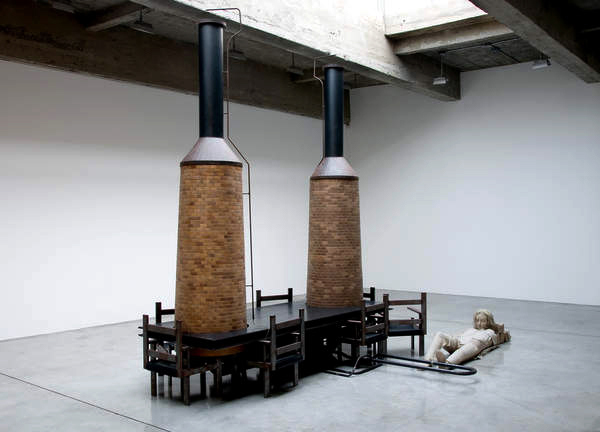Artist’s exhibition finds beauty in the ugly

Dutch artist Mark Manders infuses poetry with sculpture at his exhibition at the Hammer Museum. Sculptural assemblages “Room with Chairs and Factory” (top), “Ramble-room Chair” (left) and “Untitled” (right) are among featured works.
Courtesy of Mark Manders
MARK MANDERS: Parallel Occurrences/documented Assignments
Through Jan. 2, 2011
Hammer Museum, FREE
By Garisma Kadakia
Sept. 28, 2010 12:22 a.m.

Courtesy of Mark Manders

Courtesy of Mark Manders
Dutch artist Mark Manders chose to become a sculptor rather than a poet. Though this was the case, Manders’ ability to use words as inspiration in his artwork depicts his poetic inclinations even in sculpture.
Mark Manders: Parallel Occurrences/Documented Assignments will be on display at the Hammer Museum until Jan. 2, 2011 and shows a combination of sculpted clay works that incorporate found objects such as chairs. Most works are featured alone in their own rooms in order to minimize distraction from each piece.
Liza Kiraz, a fourth-year art history student and Hammer student educator hosting the walkthrough, said that Manders’ works are bold and harmonious.
“Manders’ works are somber yet bittersweet (because) he works a lot with shadows and textures,” Kiraz said.
In addition to sculpting the pieces, Manders chose to personally describe his artwork on placards, rather than solely relying on curators to convey their message, as is typically done in museum exhibitions. From the selection of the carpet to the arrangement of the pieces, each detail was overseen by Manders himself.
“It is good to start with something ugly,” Manders said of the brown, rugged-look carpet selection chosen for his displays.
Most of the sculptural pieces took an extended amount of time to be created, particularly the display titled “Abandoned Room, Constructed to Provide Persistent Absence,” which took almost 18 years to complete.
One featured room in the exhibition displays clay dog sculptures, inspired by Egyptian imagery. In his written description, Manders further elaborated how the image of a dog came to his mind, and what the word itself would represent ““ a method typical in his sculptural assemblages.
“Manders chose to become a sculptor rather than a poet (by) using the materials the same way a poet would,” said Douglas Fogle, chief curator of the Hammer Museum.
One other piece was created out of tea bags, reiterating his theme of how simple products can be infused with art. According to Fogle, the tea bags symbolized an array of musical notes, generating sounds, words and music all in a piece of artwork symbolizing a form of binary code.
“Manders’ use of tea bags reflects how he uses simple products that people can relate to and he somehow makes connections with things that we overlook as a public,” Kiraz said.
Manders said that he felt the need to add simple creations and physical objects such as books and chairs in order to infuse different forms of color in his works, as he mainly dealt with clay and wood in his artwork.
Another element attesting to the poetic influence in Manders’ creations was the simple use of recreated newspapers. While the newspapers used are composed of words, they feature no stories, complete sentences or even proper grammar, but rather an assortment of random words put together.
“With this kind of a newspaper it doesn’t have a location or a set time, so nobody can know when or where it was made ““ it isn’t supposed to make sense,” Manders said.


